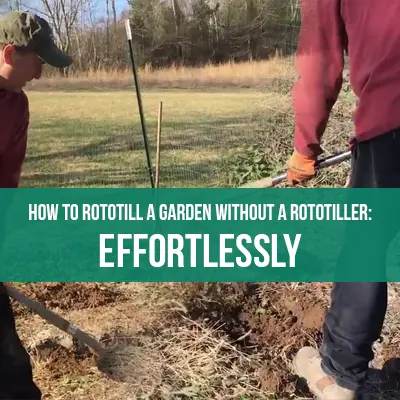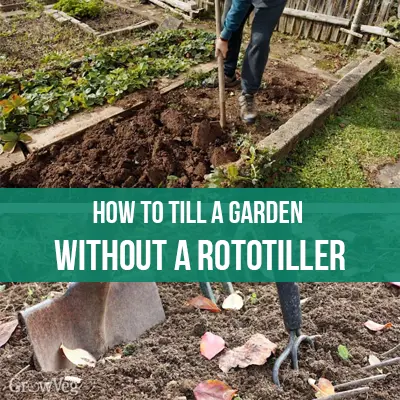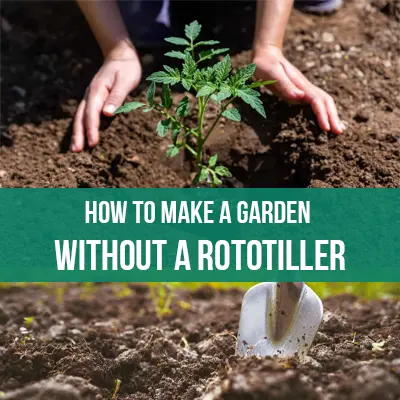
Rototill a garden without a rototiller, use a garden fork to dig and loosen the soil. This method breaks up compacted soil and prepares it for planting, enhancing drainage and root growth.
A garden is more than just a collection of plants; it is a living and evolving ecosystem that requires careful attention and maintenance. One crucial task in gardening is preparing the soil for planting. While a rototiller is the go-to tool for many gardeners, it may not always be accessible or suitable for everyone.
But fret not! There is a simple and effective solution. By using a garden fork, you can achieve the same results as a rototiller, breaking up compacted soil and ensuring it is ready for planting. In this guide, we will explore the precise steps to rototill your garden without relying on a rototiller. Let’s get started and unlock the secrets of a flourishing garden!
How To Till A Garden Without A Rototiller

Learn how to till your garden without a rototiller with these easy techniques. Use a garden fork or a sharp shovel to loosen the soil, then work your way through the garden in small sections. This method is efficient, cost-effective, and environmentally friendly.
Gardening enthusiasts often rely on rototillers to prepare their garden beds for planting. However, if you don’t have access to a rototiller or prefer a more manual approach, there are still effective methods to till your garden. We will explore alternative techniques that can help you achieve well-tilled soil, allowing your plants to thrive.
Using A Garden Fork:
- Step 1: Loosen the soil: Begin by loosening the top layer of soil with a garden fork. Insert the fork into the soil and gently rock it back and forth to break up any compacted areas.
- Step 2: Lift and turn: Once the soil is loosened, lift and turn the fork to bring the lower layers to the top. This process helps to aerate the soil and ensure proper drainage.
- Step 3: Repeat the process: Continue loosening, lifting, and turning the soil in small sections until the entire garden area is tilled. This method is effective for smaller gardens or specific areas that require deeper tilling.
Moreover, explore: Revitalize Your Lawn: Aerate Like a Pro With Garden Fork
Double Digging Method:
- Step 1: Mark the garden area: Start by marking the boundaries of your garden area using stakes and string.
- Step 2: Remove the topsoil: Use a shovel or garden spade to remove the topsoil from the marked area. Set this aside for later use.
- Step 3: Loosen the subsoil: With a garden fork or shovel, loosen the subsoil in the exposed area. Break up any clumps and remove rocks or debris.
- Step 4: Add organic matter: Mix organic matter, such as compost or well-rotted manure, into the loosened subsoil. This enriches the soil and improves its structure.
- Step 5: Replace the topsoil: Return the topsoil that was set aside earlier, layering it over the enriched subsoil. Smooth the surface with a rake.
- Step 6: Repeat the process: Repeat the steps for each marked section of your garden, ensuring the entire area is tilled effectively.
Lasagna Gardening:
- Step 1: Choose a location: Select a suitable location for your lasagna garden bed, ensuring it receives adequate sunlight.
- Step 2: Gather materials: Gather materials such as cardboard, newspapers, straw, compost, and organic matter.
- Step 3: Layer organic matter: Begin by laying down a layer of cardboard or newspaper on the ground to smother weeds and grass.
- Step 4: Alternate layers: Add alternating layers of compost, straw, and organic matter, ensuring each layer is moistened.
- Step 5: Allow decomposition: Allow the layers to naturally decompose over time, typically several months. The organic materials will break down, creating fertile soil.
- Step 6: Plant directly: Once the layers have decomposed, you can plant directly in the lasagna garden bed without traditional tilling.
Sheet Mulching Method:
- Step 1: Clear the area: Begin by removing any existing vegetation or weeds from the garden area.
- Step 2: Lay down cardboard or newspaper: Place a layer of cardboard or newspaper directly on the ground to suppress weed growth.
- Step 3: Add organic materials: Add a layer of organic materials such as leaves, grass clippings, or straw on top of the cardboard.
- Step 4: Alternate layers: Continue alternating layers of organic materials and cardboard, ensuring each layer is adequately moistened.
- Step 5: Allow decomposition: Allow the layers to decompose naturally over time, typically a few months. The organic matter will break down and enrich the soil.
- Step 6: Plant directly: Once the layers have decomposed, you can plant directly in the sheet mulched area without traditional tilling.
Following these alternative methods, you can effectively till your garden without relying on a rototiller. Each technique offers its unique benefits and can help create ideal growing conditions for your plants. Experiment with different methods to find the one that works best for your garden and enjoy the satisfaction of a well-prepared soil for planting.
How To Make A Garden Without A Rototiller

Easy steps by using alternative methods such as double digging, lasagna gardening, or using a broadfork, you can effectively prepare your garden soil and start growing your favorite plants without a rototiller.
Preparing Your Garden Bed
- Start by removing any existing vegetation or debris from the garden area.
- Use a shovel or garden fork to break up and loosen the soil.
- Spread a layer of compost or well-rotted manure on the topsoil to improve its fertility and structure.
Using Raised Beds
- Consider creating raised beds as an alternative to traditional tilling.
- Build wooden or stone borders to contain the soil within the raised bed.
- Fill the raised bed with a mixture of topsoil, compost, and organic matter.
Sheet Mulching Technique
- Clear the area of weeds and grass.
- Lay down a layer of cardboard over the entire garden bed.
- Wet the cardboard thoroughly to keep it in place and encourage decomposition.
- Add layers of organic matter on top of the cardboard, such as grass clippings, leaves, straw, or compost.
Double-digging Method
- Use a shovel to remove the top layer of soil from the garden bed.
- Loosen the subsoil by digging another shovel-depth layer.
- Mix in organic matter, such as compost or aged manure, with the loosened subsoil.
- Finally, return the topsoil to the garden bed, ensuring the organic matter is well incorporated.
Lasagna Gardening Technique
- Begin by mowing or cutting down any existing vegetation.
- Layer newspaper or cardboard over the garden bed to smother weeds.
- Add alternating layers of organic materials, such as grass clippings, leaves, compost, and straw.
- Finish with a layer of topsoil or compost.
No-dig Method
- Utilize natural processes to build fertility and soil structure over time.
- Add a layer of compost directly on top of the existing vegetation.
- Cover the compost with a thick layer of organic mulch, such as straw or wood chips.
- Repeat the process each season, allowing the organic materials to decompose and enrich the soil.
Utilizing A Garden Fork
- Use a garden fork to loosen the soil in the garden bed.
- Rock the fork back and forth to penetrate compacted soil layers.
- Continue working the fork across the entire garden bed, creating a loose and aerated soil.
Implementing Permaculture Principles
- Embrace permaculture principles to develop a low-maintenance garden.
- Plant perennial crops, such as fruit trees, shrubs, and perennial vegetables.
- Utilize strategic mulching, composting, and companion planting to improve soil health.
Implementing No-till Techniques
- Minimize soil disturbance to preserve soil structure and beneficial soil organisms.
- Use hand tools, such as a hand fork or trowel, for planting and weeding.
- Apply a thick layer of mulch to suppress weeds and retain soil moisture.
Implementing Hugelkultur
- Create a raised bed by layering logs, branches, and woody debris.
- Cover the woody base with soil, compost, and organic matter.
- The decaying wood acts as a sponge, retaining water and slowly releasing nutrients to plants.
Cultivating a garden without a rototiller requires a bit of creativity and patience. Implement one or more of these techniques depending on your garden’s specific needs and your personal preferences. Happy gardening!
In addition, don’t forget to read: How to Replace Handle Like a Pro ? Revive Your Garden Fork
How To Start A Garden Without A Rototiller
Starting a garden without a rototiller is possible with these helpful tips. Clear the ground of weeds, loosen the soil using a garden fork, add organic matter like compost, and use a hand tiller or a digging shovel for turning and loosening the soil.
Creating a garden without a rototiller might seem like a challenge, but fear not! With a few simple techniques and some good old-fashioned elbow grease, you can cultivate a thriving garden without the need for expensive machinery. Whether you’re looking to save money, reduce your carbon footprint, or simply enjoy the satisfaction of manual labor, we’ve got you covered.
Read on to discover.
Preparation Is Key:
- Clear the area: Remove any existing vegetation, debris, or rocks to create a clean canvas for your garden.
- Loosen the soil: Use a garden fork or a broadfork to loosen the soil. This will make it easier to work with and help your plants establish healthy root systems.
- Amend the soil: Mix in compost, well-rotted manure, or organic matter to improve soil fertility and structure.
No-dig Gardening Techniques:
- Lasagna gardening: Build layers of organic materials such as leaves, grass clippings, cardboard, and compost directly on top of the ground. Over time, these layers break down, creating rich, nutrient-filled soil.
- Raised bed gardening: Construct raised beds using untreated lumber or other materials, and fill them with a combination of quality soil and compost. Raised beds provide better drainage and allow for easier weed control.
- Container gardening: Grow your plants in pots or containers filled with a well-draining potting mix. This method is ideal for small spaces or areas with poor soil quality.
Manual Soil Preparation:
- Double-digging: Dig a trench in your garden bed, approximately one shovel depth. Loosen the soil in the trench with a garden fork or spade. Then, dig a second trench next to the first, using the soil from the second trench to fill in the first. This method improves soil aeration and drainage.
- Hand tilling: Use a garden fork, hoe, or cultivator to break up clumps of soil and incorporate amendments. Work in small sections, focusing on one area at a time for better control.
Planting Tips:
- Opt for plants with shallow root systems: Choose crops like lettuce, herbs, and radishes that don’t require deep soil preparation.
- Use transplants: Start your garden with young plants instead of seeds to save time and ensure successful establishment.
- Mulch: Apply a layer of organic mulch (such as straw or wood chips) around your plants to conserve moisture, suppress weeds, and regulate soil temperature.
Maintaining Your Garden:
- Regular weeding: Stay on top of weed growth by pulling them out regularly. This prevents them from competing with your plants for resources.
- Watering: Monitor soil moisture levels and water your garden when necessary. Avoid overwatering, as it can lead to root rot and other issues.
Starting a garden without a rototiller is entirely possible. By using alternative soil preparation methods, selecting suitable plants, and maintaining proper care, you can enjoy the rewards of a bountiful garden while avoiding the use of heavy machinery. So grab your gardening tools, roll up your sleeves, and embark on the rewarding journey of creating a no-rototiller garden!
Additionally, it is worth mentioning: Effortless Plant Care: Mastering How to Use Plant Watering Bulbs
How To Till Your Garden Without A Rototiller
Using alternative methods such as double-digging, sheet composting, or using a broadfork. These techniques will help you prepare your soil for planting without the need for expensive equipment.
If you don’t have access to a rototiller or prefer a more manual approach to garden tilling, there are alternatives you can use to achieve great results. By following the methods outlined below, you’ll be able to effectively till your garden without the need for a rototiller.
Use A Garden Fork:
- Insert a garden fork into the soil, spacing the insertions about 8-12 inches apart.
- Push the fork into the ground as far as possible, then rock it back and forth to loosen the soil.
- Continue this process throughout the entire garden area, working your way across in rows.
- Once complete, use the fork to break up any remaining clumps of soil.
Double-digging Method:
- Begin by using a shovel to dig a hole approximately 12 inches deep and the width of the shovel blade.
- Place the excavated soil off to the side.
- Next, dig a second hole adjacent to the first, but this time, only 6 inches deep.
- Take the soil from the second hole and place it into the first hole, effectively burying the shallower layer of soil.
- Repeat this process, digging a new hole 12 inches deep adjacent to the 6-inch hole, and transferring the soil accordingly.
- By the time you’ve completed the row, the soil will have been thoroughly mixed and broken up.
Sheet Mulching Technique:
- Start by laying down sheets of cardboard or newspaper on the garden bed.
- Wet the cardboard/newspaper thoroughly to prevent it from blowing away.
- Apply a layer of organic matter such as compost, straw, or leaves on top of the cardboard/newspaper.
- Continue layering organic matter until you reach a depth of 6-12 inches.
- Allow the layers to sit for a few weeks, allowing the organic matter to break down and improve the soil.
- Once this period has passed, the soil will be loose and easy to work with.
Cover Crop Method:
- Plant a cover crop such as rye, clover, or buckwheat in your garden bed.
- Allow the cover crop to grow for a few weeks or months, depending on the specific crop.
- When the time comes, cut the cover crop down to the ground and leave the cut material on the bed.
- Use a digging fork or garden tiller to work the cut material into the soil.
- This method not only tills the soil but also adds essential organic matter.
Lasagna Gardening:
- Begin by layering materials directly on top of the garden bed.
- Alternate layers of organic matter, such as compost, straw, leaves, and grass clippings.
- The layers can be applied in any order, with a recommended depth of 12-18 inches.
- Allow the layers to sit for several months, during which time the organic matter breaks down and enriches the soil.
- Once the layers have decomposed, the soil will be ready for planting.
Utilizing these alternative methods, you can successfully till your garden without relying on a rototiller. Choose the method that best suits your needs and get busy preparing your garden for a productive growing season.
Frequently Asked Questions For How To Rototill A Garden Without A Rototiller
What Is An Alternative To Rototilling?
One alternative to rototilling is sheet mulching. This involves layering organic materials on top of the soil to suppress weeds and enrich the soil. It is a natural and low-maintenance method that improves soil health and prevents soil disturbance.
Can You Till A Garden By Hand?
Yes, you can till a garden by hand. Hand tilling involves using tools like shovels or garden forks to break up the soil and prepare it for planting. It is a labor-intensive process but can be a rewarding way to connect with your garden.
What Is The Fastest Way To Till A Yard?
Fastest way to till a yard is by using a power tiller. It is efficient, saves time, and breaks up the soil quickly for planting.
Can You Rototill A Garden Without A Rototiller?
Yes, you can rototill a garden without a Rototiller by using alternative methods like double digging, manual tilling with a garden fork, or using a broadfork. These methods require more physical effort but can effectively break up compact soil and prepare it for planting.
Conclusion
Rototilling your garden without a rototiller is not only possible, but also a cost-effective and eco-friendly alternative. By following the steps outlined in this guide, you can achieve the same results as using a rototiller. Remember to prepare your soil, use the right tools, and exercise proper technique to ensure a successful tilling experience.
